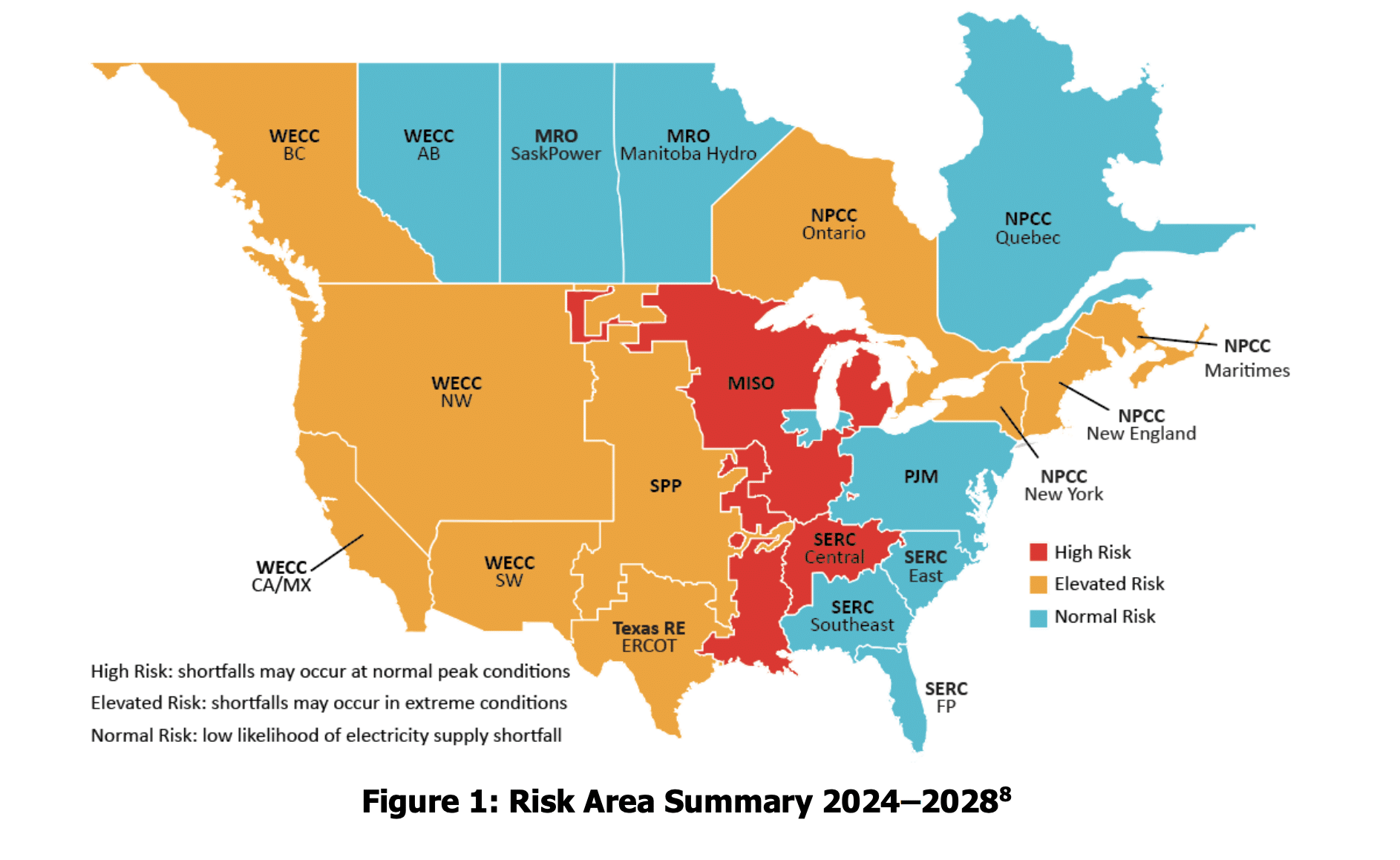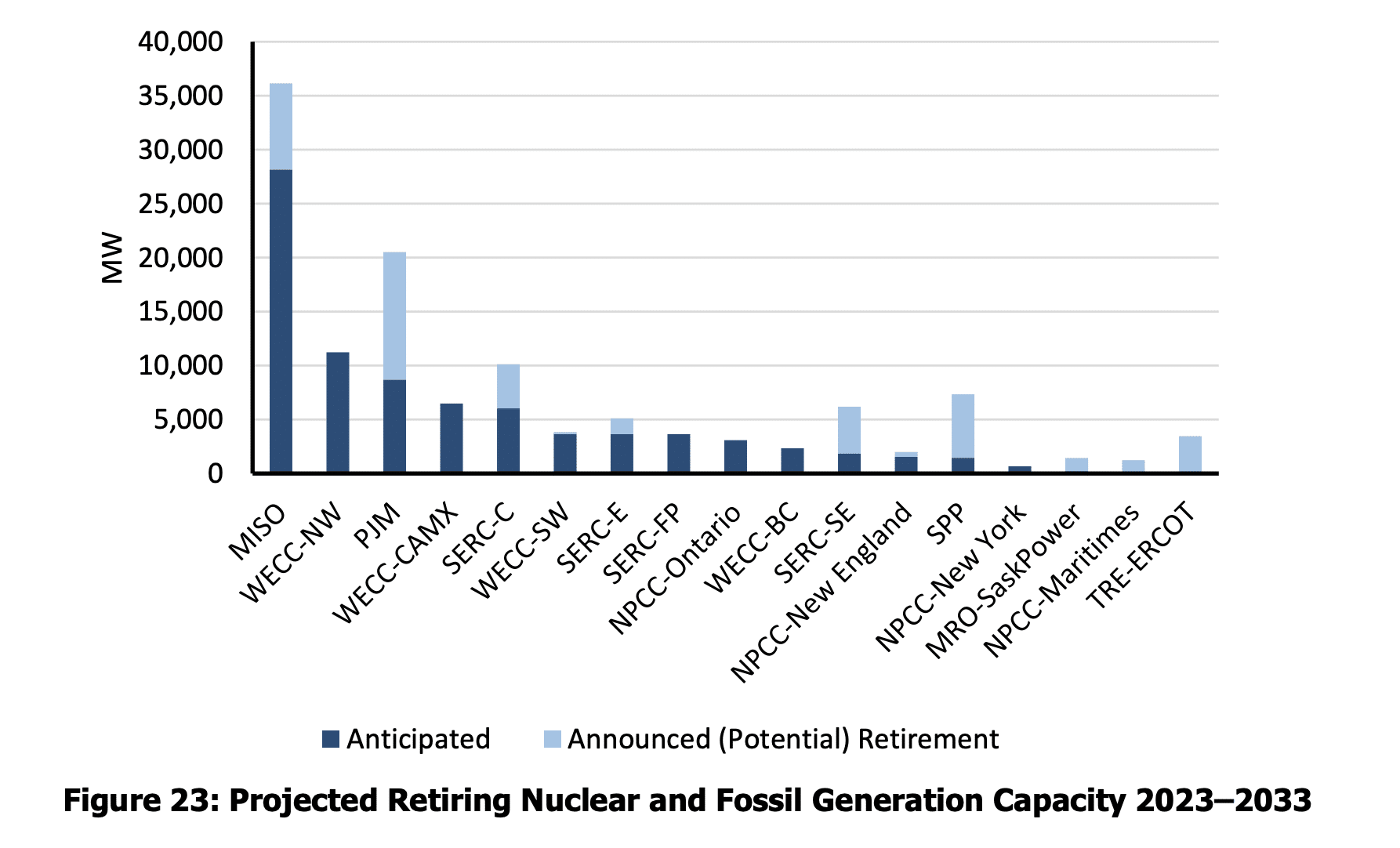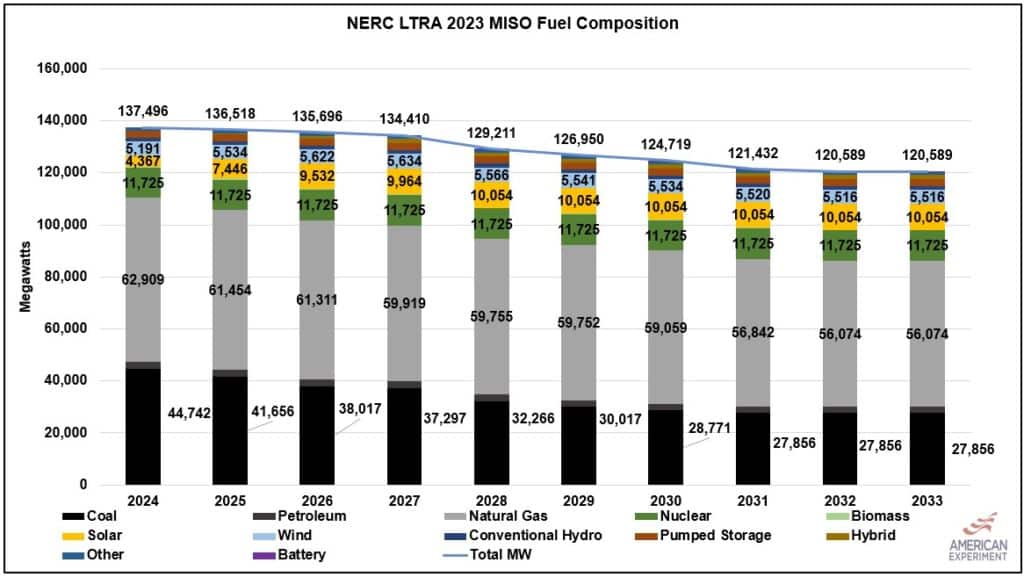
(Center of the American Experiment) — This month, the North American Electric Reliability Corporation (NERC), the international regulatory authority with the mission to ensure the reliability of the electric grid, released the latest version of its Long-Term Reliability Assessment (LTRA).
The report warns that a growing number of areas in North America face the risk of power outages, and the regional electric grid to which Minnesota belongs, the Midcontinent Independent Systems Operator (MISO), is one of the areas most at risk of rolling blackouts in the years to come, which you can see in the map below.

MISO and the SERC Central regions are most at risk of rolling blackouts in the coming years. These regions are designated as “High Risk” because there will not be enough reliable power plants to meet electricity demand in the future due to rising electricity consumption and nuclear, coal, and natural gas power plant retirements.
MISO’s missing megawatts
According to NERC, the MISO region will see far more reliable power plant retirements, meaning coal, natural gas, oil, and nuclear plants, over the next ten years than any other region.
The graph below shows that MISO is anticipated to shut down around 28,000 megawatts (MW) of reliable power plant capacity by 2033 (shown in the dark blue bars in the graph), which is twice as much reliable power plant capacity as the next-highest region studied by NERC. Overall, power companies have announced their intentions to shutter as many as 36,000 megawatts (MW) during this time, but some of these closures have not yet been approved (shown in the light blue bars in the graph).

In practice, this means that much of the MISO coal fleet will be shut down within the next ten years, but unlike other regions of the country that plan to add new natural gas plants to help make up for the reliability hole left by the lost coal plants, MISO will also lose almost 7,000 MW of natural gas plants during this timeframe.

This means that MISO will be burning the reliability candle at both ends by attempting to meet growing electricity demand while simultaneously shutting down reliable power plants. This is California-style energy policy, and it is exactly what Mitch Rolling and I have been warning about for years.
Why are these reliable plants retiring?
NERC deserves major credit for calling out the biggest culprits leading to the closure of reliable power plants: energy policy and environmental regulations. The report states:
“Environmental regulations and energy policies that are overly rigid and lack provisions for electric grid reliability have the potential to influence generators to seek deactivation despite a projected resource adequacy or operating reliability risk; this can potentially [jeopardize] the orderly transition of the resource mix. For this reason, regulators and policymakers need to consider effects on the electric grid in their rules and policies and design provisions that safeguard grid reliability.”
NERC also specifically mentions the subsidies in the “Inflation Reduction Act” and the harmful impacts of the Biden Administration’s new Environmental Protection Agency (EPA) regulations on carbon dioxide emissions from new and existing coal and natural gas-fired power plants as a problem for reliability in the future:
“Future fossil-fired generator retirements will be influenced by a range of factors, such as environmental policies, incentives for new renewable generation, operating economics, and technology developments.
The Inflation Reduction Act contains climate and energy provisions, including tax credits and expenditures that will influence the BPS resource mix by supporting renewable resources, energy storage, and nuclear generation. The Inflation Reduction Act will accelerate the energy resource transformation, including additional fossil-fired generator retirements.
While subject to change in the rulemaking process, proposed EPA regulations under Clean Air Act Section 111 to address carbon emissions from fossil-fired generators would result in an increase in the rate of generator retirements. Recent analysis and models that incorporate the potential effects of these new policies and proposed regulations illustrate projections for coal-fired generator retirements in excess of currently announced retirements.
Natural-gas-fired generator retirements are also expected to increase under proposed new EPA regulations as Generator Owners face added costs of emissions-reducing technologies. Technologies for enabling generators to operate to the new standards are also being developed.”
American Experiment’s modeling of these EPA regulations found that they would cause blackouts so large that the states of Minnesota and Wisconsin could lose all of their electricity at the same time.
NERC’s recommendations
Our region is in a reliability hole, and the first thing we need to do is stop digging. To this effect, NERC issued a series of recommendations warning that reliability must be a top priority for energy policymakers, regulators, and industry.
NERC’s first recommendation was to “add new resources with needed reliability attributes and make existing resources more dependable.” With electric companies switching from reliable power plants to unreliable wind and solar generators backed up by natural gas, NERC warns that there is “a growing risk that supplies can fall short of demand during some periods.”
To remedy this situation, NERC states that state utility regulators and grid planners need to do a better job of evaluating the reliability attributes that each electricity generator provides in their energy systems.
While NERC states that natural gas fuel supply problems represent a threat to reliability, the agency stops short of recommending that all natural gas plants have the ability to burn oil or liquefied natural gas (LNG) stored onsite to ensure these plants don’t run out of fuel when we need it most. Mitch and I think this is a mistake and that any natural gas plants that wish to be considered “reliable” should be required to store some fuel at the plant.
Things are likely to get worse in our region before they get better. Instead of rushing to close down coal plants, utilities should keep them running to ensure the lights don’t go out this winter while planning to eventually replace them with new nuclear power plants in the future. Only then will we have electricity that is reliable, affordable, and carbon-free.
















